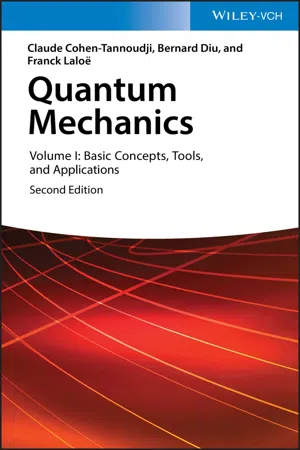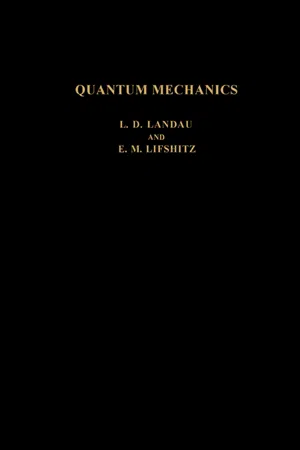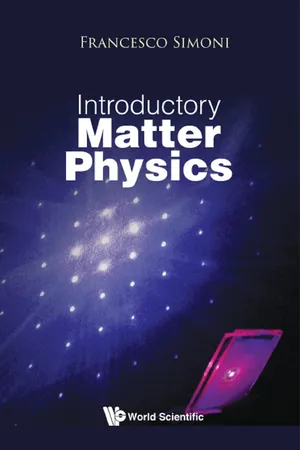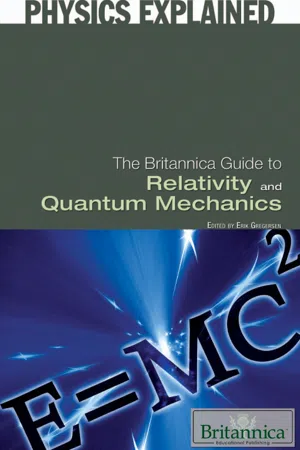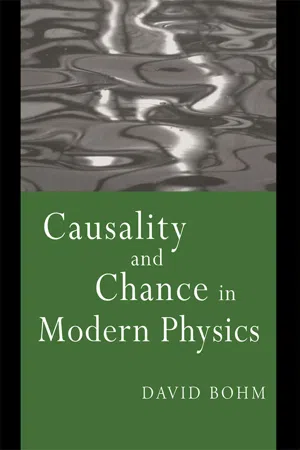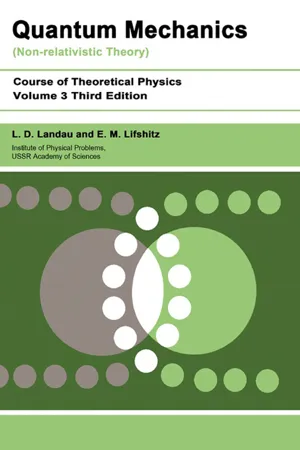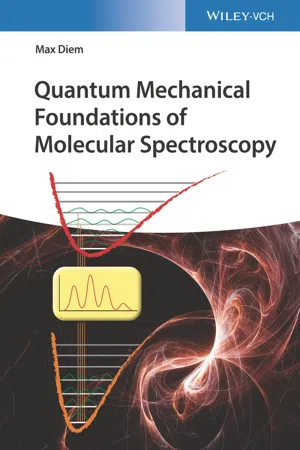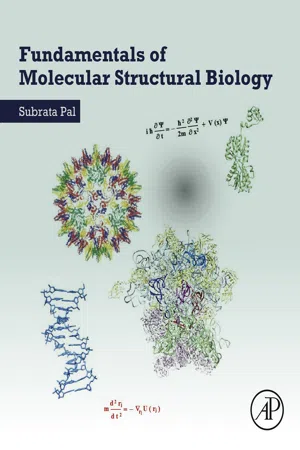Physics
Quantum Physics Basics
Quantum physics is a branch of physics that deals with the behavior of particles at the atomic and subatomic levels. It introduces the concept of quantization, where certain physical quantities, such as energy and momentum, are restricted to discrete values. Quantum physics also encompasses the wave-particle duality, which describes how particles can exhibit both wave-like and particle-like properties.
Written by Perlego with AI-assistance
Related key terms
Related key terms
1 of 4
Related key terms
1 of 3
10 Key excerpts on "Quantum Physics Basics"
- eBook - ePub
Quantum Mechanics, Volume 1
Basic Concepts, Tools, and Applications
- Claude Cohen-Tannoudji, Bernard Diu, Franck Laloë(Authors)
- 2020(Publication Date)
- Wiley-VCH(Publisher)
Chapter I Waves and particles. Introduction to the fundamental ideas of quantum mechanics- A Electromagnetic waves and photons
- A-1 Light quanta and the Planck-Einstein relations
- A-2 Wave-particle duality
- A-3 The principle of spectral decomposition
- B Material particles and matter waves
- B-1 The de Broglie relations
- B-2 Wave functions. Schrödinger equation
- C Quantum description of a particle. Wave packets
- C-1 Free particle
- C-2 Form of the wave packet at a given time
- C-3 Heisenberg relations
- C-4 Time evolution of a free wave packet
- D Particle in a time-independent scalar potential
- D-1 Separation of variables. Stationary states
- D-2 One-dimensional “square” potentials. Qualitative study
In the present state of scientific knowledge, quantum mechanics plays a fundamental role in the description and understanding of natural phenomena. In fact, phenomena that occur on a very small (atomic or subatomic) scale cannot be explained outside the framework of quantum physics. For example, the existence and the properties of atoms, the chemical bond and the propagation of an electron in a crystal cannot be understood in terms of classical mechanics. Even when we are concerned only with macroscopic physical objects (that is, whose dimensions are comparable to those encountered in everyday life), it is necessary, in principle, to begin by studying the behavior of their various constituent atoms, ions, electrons, in order to arrive at a complete scientific description. Actually, there are many phenomena that reveal, on a macroscopic scale, the quantum behaviour of nature. It is in this sense that it can be said that quantum mechanics is the basis of our present understanding of all natural phenomena, including those traditionally treated in chemistry, biology, etc...From a historical point of view, quantum ideas contributed to a remarkable unification of the concepts of fundamental physics by treating material particles and radiation on the same footing. At the end of the nineteenth century, people distinguished between two entities in physical phenomena: matter and radiation. Completely different laws were used for each one. To predict the motion of material bodies, the laws of Newtonian mechanics (cf. Appendix III) were utilized. Their success, though of long standing, was none the less impressive. With regard to radiation, the theory of electromagnetism, thanks to the introduction of Maxwell’s equations, had produced a unified interpretation of a set of phenomena which had previously been considered as belonging to different domains: electricity, magnetism and optics. In particular, the electromagnetic theory of radiation had been spectacularly confirmed experimentally by the discovery of Hertzian waves. Finally, interactions between radiation and matter - eBook - ePub
Quantum Mechanics
A Shorter Course of Theoretical Physics
- L D Landau, E. M. Lifshitz(Authors)
- 2013(Publication Date)
- Pergamon(Publisher)
CHAPTER 1THE BASIC CONCEPTS OF QUANTUM MECHANICS
Publisher Summary
This chapter discusses the basic concepts of quantum mechanics. The mechanics which governs atomic phenomena—quantum mechanics or wave mechanics—must be based on ideas of motion which are fundamentally different from those of classical mechanics. In quantum mechanics there is no such concept as the path of a particle. This forms the content of what is called the uncertainty principle, one of the fundamental principles of quantum mechanics, discovered by W. Heisenberg in 1927. In that it rejects the ordinary ideas of classical mechanics, the uncertainty principle might be said to be negative in content. This principle in itself does not suffice as a basis on which to construct a new mechanics of particles. Such a theory must naturally be founded on some positive assertions, which are also discussed in the chapter. However, in order to formulate these assertions, one must first ascertain the statement of the problems that confront quantum mechanics. To do so, the special nature of the interrelation between quantum mechanics and classical mechanics is examined. A more general theory can usually be formulated in a logically complete manner, independently of a less general theory which forms a limiting case of it. Thus, relativistic mechanics can be constructed on the basis of its own fundamental principles, without any reference to Newtonian mechanics.§1. The uncertainty principle
When we attempt to apply classical mechanics and electrodynamics to explain atomic phenomena, they lead to results which are in obvious conflict with experiment. This is very clearly seen from the contradiction obtained on applying ordinary electrodynamics to a model of an atom in which the electrons move round the nucleus in classical orbits. During such motion, as in any accelerated motion of charges, the electrons would have to emit electromagnetic waves continually. By this emission, the electrons would lose their energy, and this would eventually cause them to fall into the nucleus. Thus, according to classical electrodynamics, the atom would be unstable, which does not at all agree with reality. - eBook - ePub
- Francesco Simoni(Author)
- 2018(Publication Date)
- WSPC(Publisher)
Chapter 2
The Basics of Quantum Mechanics
2.1. The old quantum theory
We know that the physical sciences have been developing continuously since the setup of novel experimental methods paved the way for new research areas, and at the same time the theoretical explanation of physical phenomena has been pushing scientists to perform new experiments. For this reason, a good scientist should be ready to change his or her point of view concerning the interpretation of phenomena. Thanks to this open-mindedness, Galilei and Newton were able to change the approach to natural phenomena that had lasted many centuries since the time of the Greek philosophers. More recently, Planck, Einstein, Bohr, de Broglie, Heisenberg, Born, Dirac and many more clever scientists have been able to overcome the crisis of classical physics by developing the theory of quantum mechanics.The crisis occurred at the end of 1800 and the beginning of 1900, owing to a number of experimental facts which could not be explained following classical mechanics and classical electromagnetism. These experimental facts could fall neither into the frame of Newton’s mechanics nor into the frame of Maxwell’s equations. They made questionable the sharp border between the wave description of electromagnetic radiation and the corpuscular description of elementary particles.The main observations leading to the new point of view for the microscopic world concerned the light–matter interaction and the atomic structure.The explanation given by Max Planck for the spectrum of blackbody radiation is historically the beginning of this story, since he introduced for the first time the idea of the energy packet, opening the way to the concept of a quantum of energy, a basic one for the new theory. It is well known that all materials emit electromagnetic radiation with a spectral distribution dependent on the temperature of the emitting body. While at room temperature emission is usually in the infrared, by increasing the temperature to some hundreds of degrees Celsius emission is visible, giving rise to incandescence which occurs at a temperature dependent on the particular material. At the same time, the emitted power increases with temperature. This process can be studied by considering a hollow box with walls maintained at a constant temperature. The radiation inside the box is in thermal equilibrium with the walls and can be analyzed through a small hole that allows the exit of radiation. Since external radiation entering through the hole will be completely absorbed by the walls after a large number of reflections, the box is called a blackbody - Britannica Educational Publishing, Erik Gregersen(Authors)
- 2010(Publication Date)
- Britannica Educational Publishing(Publisher)
CHAPTER 3 QUANTUM MECHANICS : CONCEPTSQ uantum mechanics is the science dealing with the behaviour of matter and light on the atomic and subatomic scale. It attempts to describe and account for the properties of molecules and atoms and their constituents—electrons, protons, neutrons, and other more esoteric particles such as quarks and gluons. These properties include the interactions of the particles with one another and with electromagnetic radiation (i.e., light, X-rays, and gamma rays).HISTORICAL BASIS OF QUANTUM THEORY
At a fundamental level, both radiation and matter have characteristics of particles and waves. The gradual recognition by scientists that radiation has particle-like properties and that matter has wavelike properties provided the impetus for the development of quantum mechanics. Influenced by Newton, most physicists of the 18th century believed that light consisted of particles, which they called corpuscles. From about 1800, evidence began to accumulate for a wave theory of light. At about this time Thomas Young showed that, if monochromatic light passes through a pair of slits, the two emerging beams interfere, so that a fringe pattern of alternately bright and dark bands appears on a screen. The bands are readily explained by a wave theory of light. According to the theory, a bright band is produced when the crests (and troughs) of the waves from the two slits arrive together at the screen; a dark band is produced when the crest of one wave arrives at the same time as the trough of the other, and the effects of the two light beams cancel. Beginning in 1815, a series of experiments by Augustin-Jean Fresnel of France and others showed that, when a parallel beam of light passes through a single slit, the emerging beam is no longer parallel but starts to diverge; this phenomenon is known as diffraction. Given the wavelength of the light and the geometry of the apparatus (i.e., the separation and widths of the slits and the distance from the slits to the screen), one can use the wave theory to calculate the expected pattern in each case; the theory agrees precisely with the experimental data.- eBook - ePub
The Language of Modern Physics
An Introduction to the Philosophy of Science
- Ernest H. Hutten(Author)
- 2022(Publication Date)
- Routledge(Publisher)
V Quantum Physics 1. Historical survey The discovery of the quantum of action in 1900 heralded a radically new departure in physics; it led in 1926 to the theory of quantum mechanics which was widely acclaimed as a revolution. Quantum theory has created a fundamental change in our ideas as relativity theory had done before. But while relativity theory is essentially classical in its conceptions—it is in fact the culmination of classical physics—quantum mechanics is founded on some new principles. The quantum laws are very different in character from the laws we find in classical theory. In particular, quantum mechanics is a strictly statistical type of theory : from this arises the different conception of causality that marks the new outlook of modern physics. The novel feature of this theory is that energy is regarded as existing in discrete amounts, i.e. quanta. Any given amount of energy may be thought of as an integral multiple of an isolated unit while, in classical physics, energy is something which varies in a continuous manner. And, from the logical viewpoint, the strange and ‘abstract’, not to say abstruse, nature of the new concepts made it necessary to be more critical about the construction of our theories; it resulted, ultimately, in a better understanding of all physics. Planck introduced the idea of a discrete quantum of energy in order to overcome the failure of the classical laws of radiation. Einstein, in 1905, extended this idea to the description of the phenomena of light; and he formulated his famous photon theory which, in a different form, re-created the corpuscular theory of light as held by Newton. Finally, basing his work upon the experimental research of Rutherford into the structure of the atom, Bohr in 1913 applied the conception of energy quanta to the emission and absorption of light by atoms. He invented a theory about the constitution of atoms which, immediately, led to great success - eBook - ePub
Applied Quantum Computers
Learn about the Concept, Architecture, Tools, and Adoption Strategies for Quantum Computing and Artificial Intelligence (English Edition)
- Dr. Patanjali Kashyap(Author)
- 2023(Publication Date)
- BPB Publications(Publisher)
- Quantum mechanics is the game-changer; it provided a new perspective to visualize the world. If quantum physics is not around, we will not be able to understand and decode life itself. Quantum mechanics elucidates the possessions of materials, such as what brands a metal, as a conductor of electrical energy, while another one is an insulator. It enlightens us about the working of light and radioactivity and serves as the foundational forces of nuclear physics. It explains the cosmos and tells us why stars and galaxies behave the way they do. We would not even be able to create computer chips without quantum physics. Its areas of applications are wide-ranging. And now it is fulling to one of the greatest technological revolutions of humankind called quantum computers. As mentioned earlier, Quantum computers would change almost everything in the coming time and it affects almost all areas of our life. Similarly, all things which are present are having quantum stuff – either it is elementary particles, or atoms and molecules. Also, all things possess both a particle and a wave nature because fundamentally they are quantum beings.
- A switch in a classical manner could be defined as a small button or something similar that you press up or down in order to turn on the electricity. Whereas the term "quantum switch" refers to a quantum operation in which a quantum system is affected by two or more quantum channels, the order of which is determined by the state of an order quantum system. Additionally, one can establish a quantum superposition of the various orders of application by carefully selecting the state of the order system, which enables one to do communication tasks that are not achievable using the normal quantum Shannon theory.
The narration of quantum physics is required for anyone who wants to appreciate the technicalities of QC. Hence, in the next few sections of the chapter, we will cover fundamentals, classical concepts of quantum physics, interrelation among quantum physics and quantum computers, and the History of QP. Hold on, covering fundamentals are OK…But why history? Because history predicts the future.The birth of quantum physics
To understand the gamut of light produced by hot bodies, commonly understood as blackbody radiation, quantum physics was born. Understanding blackbody radiation was the starting point of quantum mechanics. As per the concept of black body radiation, when hot matter is luminous, it becomes hotter and hotter. Slowly it turns out to be brighter and starts glowing. The spectrum of the light is extensive, with a top that changes from red to yellow and to end to blue as the temperature is elevated. It should have been feasible to comprehend the form of the spectrum by uniting thoughts from thermodynamics and electromagnetic theory, but all efforts are unsuccessful. Nevertheless, we will presume that the energies of the vibrant electrons that emit the light are quantized (when something is quantized, it means that it derives in distinct lumps, named “quanta”). Planck got a countenance that approved it nicely with experimentation. But as he documented all too well, the concept was physically seeming silly, an act of distraction, as he later labelled it. - eBook - ePub
- David Bohm(Author)
- 2004(Publication Date)
- Routledge(Publisher)
CHAPTER THREE: The Quantum Theory
1. INTRODUCTION
IN the previous chapter we have given a discussion on the evolution of classical physics, starting with Newton’s laws of motion, and continuing on to all the new developments which occurred up to the end of the nineteenth century. Throughout this time, however, the general philosophical view held by physicists was that of deterministic mechanism. For it was felt that even though the details of the theories that were then current would eventually have to undergo various modifications in response to the results of further experiments, the basic general scheme in which all theories are formulated in terms of differential equations determining the future behaviour of everything in the universe completely in terms of their states at a given instant of time would never have to be changed. For example, Lord Kelvin, one of the leading physicists of the time, expressed the opinion that the basic general outline of physical theories was pretty well settled, and that there remained only “two small clouds” on the horizon, namely, the negative results of the Michelson-Morley experiment and the failure of Rayleigh-Jeans law to predict the distribution of radiant energy in a black body. It must be admitted that Lord Kelvin knew how to choose his “clouds”, since these were precisely the two problems that eventually led to the revolutionary changes in the conceptual structure of physics that occurred in the twentieth century in connection with the theory of relativity and the quantum theory.Now, while the theory of relativity brought about important modifications in the specific forms in which the causal laws are expressed in physics, it did not go outside the previously existing theoretical scheme, in which the values of suitable parameters at a given instant of time would in principle determine the future behaviour of the universe for all time. We shall, therefore, not discuss the theory of relativity in this book, in which we are interested primarily in the question of causality, because this theory raised no question that went to the root of the problem of causality. - eBook - ePub
Quantum Mechanics
Non-Relativistic Theory
- L D Landau, E.M. Lifshitz(Authors)
- 1981(Publication Date)
- Butterworth-Heinemann(Publisher)
CHAPTER ITHE BASIC CONCEPTS OF QUANTUM MECHANICS
§1 The uncertainty principle
When we attempt to apply classical mechanics and electrodynamics to explain atomic phenomena, they lead to results which are in obvious conflict with experiment. This is very clearly seen from the contradiction obtained on applying ordinary electrodynamics to a model of an atom in which the electrons move round the nucleus in classical orbits. During such motion, as in any accelerated motion of charges, the electrons would have to emit electromagnetic waves continually. By this emission, the electrons would lose their energy, and this would eventually cause them to fall into the nucleus. Thus, according to classical electrodynamics, the atom would be unstable, which does not at all agree with reality.This marked contradiction between theory and experiment indicates that the construction of a theory applicable to atomic phenomena—that is, phenomena occurring in particles of very small mass at very small distances—demands a fundamental modification of the basic physical concepts and laws.As a starting-point for an investigation of these modifications, it is convenient to take the experimentally observed phenomenon known as electron diffraction .† It is found that, when a homogeneous beam of electrons passes through a crystal, the emergent beam exhibits a pattern of alternate maxima and minima of intensity, wholly similar to the diffraction pattern observed in the diffraction of electromagnetic waves. Thus, under certain conditions, the behaviour of material particles—in this case, the electrons—displays features belonging to wave processes.How markedly this phenomenon contradicts the usual ideas of motion is best seen from the following imaginary experiment, an idealization of the experiment of electron diffraction by a crystal. Let us imagine a screen impermeable to electrons, in which two slits are cut. On observing the passage of a beam of electrons‡ - Max Diem(Author)
- 2021(Publication Date)
- Wiley-VCH(Publisher)
2 Principles of Quantum MechanicsQuantum mechanics presents an approach to describe the behavior of microscopic systems. Whereas in classical mechanics the position and momentum of a moving particle can be established simultaneously, Heisenberg's uncertainty principle prohibits the simultaneous determination of those two quantities. This is manifested by Eq. (2.1) :(2.1)which implies that the uncertainty in the momentum and position always exceeds ħ/2, where ħ is Planck's constant divided by 2π. Mathematically, Eq. (2.1) follows from the fact that the operators responsible for defining position and momentum, and , do not commutate; that is, . (This aspect will be discussed in more detail at the end of Section 2.1 .) As we shall see later (Chapter 5 ), the uncertainty principle also can be rewritten in terms of the uncertainty in energy and lifetime of a spectroscopic state or in frequency and time of a wave.The incorporation of this uncertainty into the picture of the motion of microscopic particles leads to discrepancies between classical and quantum mechanics: classical physics has a deterministic outcome, which implies that if the position and velocity (trajectory) of a moving body are established, it is possible to predict with certainty where it is going to be found in the future. This principle certainly holds at the macroscopic scale: if the position and trajectory of a macroscopic body, for example, the moon, are known, it is certainly possible to calculate its position six days from now and to send a spaceship to this predicted position.Quantum mechanical systems, on the other hand, obey a probabilistic behavior. Since the position and momentum can never be determined simultaneously at any point in time, the position (or momentum) in the future cannot be precisely predicted, only the probability of either of them. This is manifested in the postulate that all properties, present or future, of a particle are contained in a quantity known as the wavefunction Ψ of a system. This function, in general, depends on spatial coordinates and time; thus, for a one‐dimensional motion (to be discussed first), the wavefunction is written as Ψ(x, t). The probability of finding a quantum mechanical system at any time is given by the integral of the square of this wavefunction: ∫Ψ(x, t)2 dx. This is, in fact, one of the “postulates” on which quantum mechanics is based to be discussed next. Different authors list these postulates in different orders and include different postulates necessary for the description of quantum mechanical systems [1- eBook - ePub
- Subrata Pal(Author)
- 2019(Publication Date)
- Academic Press(Publisher)
Chapter 3Physical basis of chemistry
Abstract
Physics has been the chief agent in transforming molecular biology into molecular structural biology. This chapter gives an overview of different areas of physics as a minimum requirement for the experimental and theoretical understanding of biomolecular interactions and dynamics. The layout of the topics is somewhat similar to one that would appear in an exclusive textbook on basic physics—classical mechanics, wave motion, kinetic theory and thermodynamics, and quantum and statistical physics; nevertheless, the presentation here is purely introductory. In each of the topics, mathematical expressions and equations have been judiciously used to deliver some quantitative sense. All such is expected to facilitate meaningful deliberations in the subsequent chapters.Keywords
Classical mechanics; Wave motion; Kinetic theory and thermodynamics; Quantum physics; StatisticsRichard Feynman, Nobel Laureate in Physics in 1965, had said, “there is nothing that living things do that cannot be understood from the point of view that they are made of atoms acting according to the laws of physics.” On the one hand, physics has provided very powerful techniques such as X-ray crystallography, a wide variety of spectroscopy, and electron microscopy to investigate the biological system at the atomic level. At the same time, physics has also placed chemistry on a sound theoretical foundation from where it has been able to characterize complex molecules and unravel intricate molecular mechanisms of life.3.1 Classical mechanics
3.1.1 Matter and motion
Let us begin by considering an object in motion. The simplest object would be a dimensionless particle. At any particular time t , the location of the particle can be denoted by the position vector r :r = xi ˆ+ yj ˆ+ zk ˆ(3.1)wherei ˆ,j ˆ, andk ˆ
Index pages curate the most relevant extracts from our library of academic textbooks. They’ve been created using an in-house natural language model (NLM), each adding context and meaning to key research topics.
Explore more topic indexes
Explore more topic indexes
1 of 6
Explore more topic indexes
1 of 4
